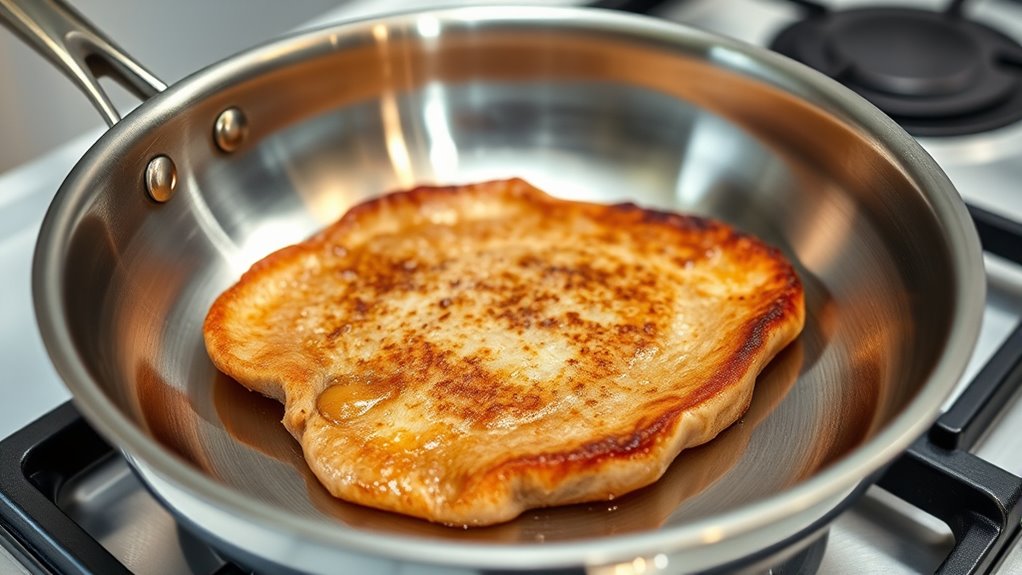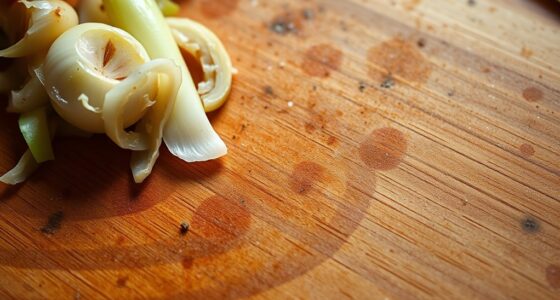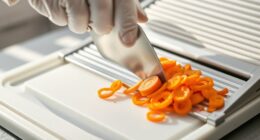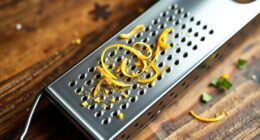To master stuck‑free searing on stainless steel, start by properly heating your pan over medium-high heat until droplets dance and evaporate. Add enough oil or fat, then wait until it shimmers before placing your food to create a barrier that prevents sticking. Allow the food to develop a crust before flipping, and resist the urge to move it too soon. Proper technique and maintenance lead to excellent searing results—discover more tips to perfect your process.
Key Takeaways
- Properly preheat the stainless steel pan on medium-high until water droplets dance and evaporate.
- Add enough oil after heating to create a shimmering barrier that prevents sticking.
- Place food into the hot pan and avoid moving it until a crust forms and natural release occurs.
- Allow crust development before flipping or poking to minimize sticking and ensure a good sear.
- Clean and maintain the pan regularly to preserve smooth surfaces and prevent surface roughness that causes sticking.
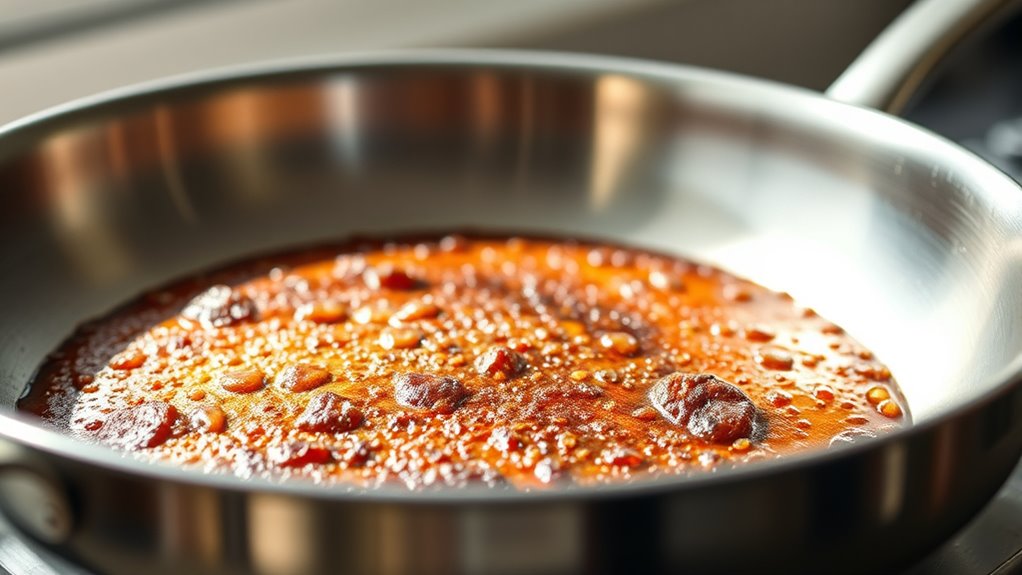
Have you ever wondered how to achieve a perfect sear on your steak or vegetables using stainless steel? Mastering this skill depends on understanding essential cooking techniques and proper pan maintenance. When you start cooking, it’s imperative to ensure your stainless steel pan is properly heated before adding any food. This step helps prevent sticking and creates that desirable, evenly browned crust. To do this, turn your burner to medium-high and let the pan warm up for a few minutes. You can test if it’s ready by sprinkling a few drops of water onto the surface—if they dance and evaporate almost immediately, your pan is hot enough. This simple trick is part of good pan maintenance and will greatly improve your searing results.
Once the pan is hot, add your cooking fat and let it heat until shimmering. Using enough oil or fat is essential because it acts as a barrier between the food and the surface, reducing the chances of sticking. Remember, patience is key here. Avoid the temptation to move or flip your food too early. When you place your steak or vegetables into the pan, you should hear a satisfying sizzle. If you don’t, the pan isn’t hot enough, and your food might stick. Making sure your pan is properly maintained and preheated aligns with good cooking techniques, helping you achieve that perfect sear without frustration.
As your food cooks, resist the urge to poke or flip too often. Give it time to develop a crust—usually a few minutes per side, depending on thickness. When the food naturally releases from the pan with a gentle nudge, it’s a sign that a good sear has formed. If you notice sticking, don’t immediately scrape it off; instead, let the pan heat up further or add a tiny bit more oil. Regularly maintaining your stainless steel pan by cleaning it properly after each use and avoiding abrasive scrubbers will keep the surface smooth and less prone to sticking in the future. Additionally, understanding AI-driven solutions in research can inspire innovative techniques for cookware design and maintenance.
Frequently Asked Questions
How Do I Prevent Stainless Steel From Warping During High-Heat Searing?
To prevent stainless steel from warping during high-heat searing, you should guarantee even heat distribution by preheating the pan gradually. Avoid sudden temperature changes to minimize material expansion stress. Use a thick, high-quality pan to better withstand heat and reduce warping risks. Keep the heat at a manageable level, and don’t let the pan overheat. This combination helps maintain shape and ensures consistent searing results.
What’s the Best Way to Clean Stainless Steel After a Sticky Sear?
Cleaning up after a sticky sear on stainless steel can feel like battling a mountain of residue! Start by soaking the pan in warm, soapy water to loosen stuck bits. Use a non-abrasive scrubber or baking soda paste for gentle residue removal, avoiding scratches. For stubborn spots, a vinegar solution works wonders. Always rinse thoroughly and dry immediately to keep your stainless steel shining like new.
Can I Use Non-Stick Sprays on Stainless Steel for Searing?
You can use non-stick sprays on stainless steel, but they might impact searing effectiveness. These sprays can create a thin coating that prevents direct contact between the food and the metal, reducing the crispness and browning you want during searing. For the best results, use a high-smoke-point oil like canola or grapeseed, which helps achieve a perfect sear without sticking, ensuring peak searing effectiveness on your stainless steel cookware.
How Do I Achieve a Consistent Sear Across Different Stainless Steel Pans?
Think of your pan as a stage for a perfect performance. To get a consistent sear across different stainless steel pans, you need to control pan temperature and choose the right oil. Preheat each pan until it’s hot enough—think of it as warming up your actors. Use oils with high smoke points, like canola or avocado, to ensure even searing without sticking. Adjust heat as needed for uniform results every time.
Is It Safe to Use Metal Utensils on Stainless Steel for Searing?
Using metal utensils on stainless steel is generally safe, but you should be cautious about stainless steel scratches. Metal utensils are durable and won’t damage the pan during searing, but they can cause minor scratches over time. To protect your cookware, consider using silicone or wooden utensils for delicate tasks. This way, you maintain the pan’s surface while still benefiting from the durability of metal utensils when needed.
Conclusion
Mastering stainless steel searing is like learning to dance with fire—once you find the rhythm, you’ll never miss a step. With patience and practice, you’ll turn your pan into a trusted partner that browns and crisps without sticking. Remember, every sear is a step closer to culinary mastery. Stick with it, and soon, your skillet will sing with the perfect crust, proving that persistence turns even the stickiest moments into a delicious victory.
